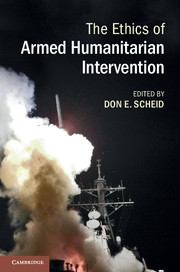Book contents
- Frontmatter
- Contents
- Notes on contributors
- Preface and acknowledgments
- List of abbreviations and acronyms
- Part I Intervention and debate
- 1 Introduction to armed humanitarian intervention
- 2 Revisiting armed humanitarian intervention
- 3 The responsibility to protect and the war in Libya
- Part II Moral perspectives
- Part III Ideas and reconsiderations
- Select bibliography
- Index
- References
3 - The responsibility to protect and the war in Libya
Published online by Cambridge University Press: 05 June 2014
- Frontmatter
- Contents
- Notes on contributors
- Preface and acknowledgments
- List of abbreviations and acronyms
- Part I Intervention and debate
- 1 Introduction to armed humanitarian intervention
- 2 Revisiting armed humanitarian intervention
- 3 The responsibility to protect and the war in Libya
- Part II Moral perspectives
- Part III Ideas and reconsiderations
- Select bibliography
- Index
- References
Summary
A new chapter in the history of international relations was inaugurated in 1999 when NATO military forces intervened in Yugoslavia to defend ethnic Albanians in the province of Kosovo, over the objections of Yugoslavia. It is no coincidence that the intervention occurred after the end of the Cold War; the Soviet Union no longer existed, and Russia was not ready for a confrontation. The Western nations that initiated the intervention had not obtained a formal decision from any international organization, like the United Nations – which, in any event, does not have its own military branch. This intervention was founded on a doctrine formulated a few years earlier. At the outset (1988), this was a simple demand to be able to provide humanitarian assistance to populations in distress; but it was progressively transformed (1991) into a proclamation of the right to intervene militarily in a country in crisis. The revelation of the Rwandan genocide (1994) seemed to argue in its favor, and since that time people have spoken of a “right of intervention.” Subscribing to this doctrine amounts to claiming that if human-rights violations occur in a country, then other countries around the world have the right to intervene through force to protect the victims and to prevent the aggressors from acting.
In Yugoslavia, the application of these principles revealed a number of problems inherent in the doctrine. Some concern doubts about information: Each of the two opposing forces has an interest in inflating the number of its victims and in concealing its own attacks (the manipulation of data is a shared temptation). In this regard, the Albanian minority was more effective than the Serbian majority; they succeeded in convincing American diplomats and NATO that they were the main victims of the violence (it is also possible that the choice was made even before the manipulation of information began). A second problem stems from the necessarily selective application of the principle. Human-rights violations are, unfortunately, quite numerous, and intervening everywhere is impossible; so one tends to spare political friends and to unleash forces against those who are pursuing a policy contrary to one’s own interests. As a result, the impartiality of the choice is jeopardized. A third problem arises from the very form of the interference, namely, a war with its inevitable consequences: bombings, destruction of the country and its inhabitants, countless sorrows.
Keywords
- Type
- Chapter
- Information
- The Ethics of Armed Humanitarian Intervention , pp. 46 - 58Publisher: Cambridge University PressPrint publication year: 2014

